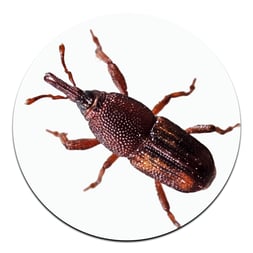A Closer Look with Heather Patterson
With cereal, pasta, decorative specimens, taxidermy, and so much more on their menu, stored product pests (SPPs) can be a real pain for homeowners. When PMPs get a call for help for a stored product pest problem, infestations are usually established, and pests have been repeatedly seen crawling or flying around specific areas of their home. SPPs are commonly encountered insect pests, and here are a few facts worth knowing about them:
Stored product pests cause a lot of damage to the food supply and are estimated to destroy about 10% of grain per yearThese pests can have a significant economic impact and dramatically affect the quality of grain. Losses are a result of direct feeding of grain, damage or deterioration of products, and product contamination from infestations.
Stored product pests will consume items other than stored food products
While it is common for stored product pests to be in the pantry, sometimes a deeper investigation is needed to find non-food sources. Some interesting items SPPs have been found infesting include dried flowers, tobacco, rodent bait, dog food and treats, bird seed, decorative pieces made with plants or animals (think corn kernels for Thanksgiving!), and bean bags.
When it comes to dealing with SPP infestations, it’s good to be good at asking questionsSince much of the solution depends on finding and eliminating the source of the infestation, figuring out where the infested products are located can be tricky. Where is the cat food or bird seed stored? Is food being stashed in a drawer of the home office desk? Any old rodent bait hiding out of sight? What about stored decorative arrangements that contain dried flowers?
Common SPP culprits: granary weevils, lesser grain borers, Indian meal moths, red flour beetles, sawtoothed grain beetles
The list of pests known to damage, infest, and deteriorate grain-, plant-, and even animal-based products around the home include several beetle and moth species. Where and how they damage these food and non-food items, as well as which life stage causes the damage, depends on the species.
You don’t have to toss out infested items of sentimental value
In instances where SPPs have damaged special pieces belonging to the homeowner, placing those items in the freezer can be a great option to consider. While there are some variables that can affect the efficacy of this control method (extreme cold), in many cases, keeping them in a freezer (0°F) for 7 days should do the trick.
References
Hedges, S.A. (2011). Mallis Handbook of Pest Control, 10th Edition. The Mallis Handbook Company.
Hedges, S.A and Lacey, M.S. (1995). Pest Control Technology: Field Guide for the Management of Structure-Infesting Beetles (Volume II: Stored Product Beetles/Occasional & Overwintering Beetles). Cleveland, OH: Franzak & Foster Co.
Mueller, D.K. (1998). Stored Product Protection: A Period of Transition. Indianapolis, ID. Insects Limited, Inc.
PCO Technical Services Manager